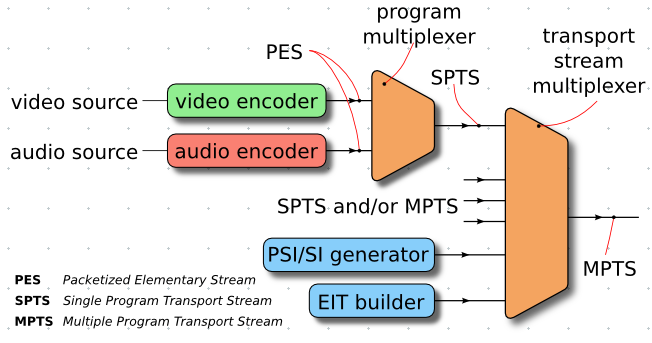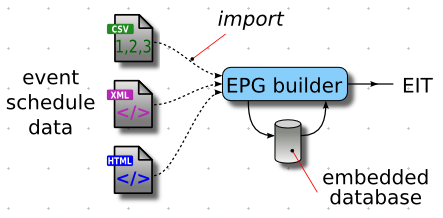Enable EPG on your system today!
Follow the simple installations steps to run your own EPG server and generate a data stream with EIT and other DVB tables.
Electronic Program Guide EPG is a service for television, radio or other multimedia application displaying information about currently broadcasted content. The user can browse through information on present or following program content. Often EPG is based on some dedicated middleware for set-top-boxes. They differ by target distribution technology, implemented features, middleware and required bandwidth.

An elementary EPG implementation without requirements on special middleware is defined by the EN 300 468. The standard defines EPG data to be carried out through Event Information Tables (EIT). These tables are multiplexed within a MPEG-2 transport stream along with other tables and service data. The delivery mechanism can be satellite, cable or terrestrial network.
EIT are generated independently for each service. The table for each service is subdivided into sub-tables, segments and sections. EIT of all services share the same bandwidth and Packet IDentifier (PID) within a MPEG-2 transport stream.
EIT is part of the Program-specific information (PSI) and Service information (SI) tables defined by MPEG-2 and DVB standards. Other important tables from these mentioned standards are: PAT, PMT, NIT, SDT, CAT, TDT, TOT. With exception to Time and Date Table (TDT) these tables are more or less static and not very complex to build. Therefore DVB multiplexers on the market have integrated capabilities to build and play these tables.
EIT on the other hand is based on dynamic data and must be updated very often. Separate devices called EPG Builder, EPG Generator or EPG Inserter are used for this task. A general implementation of a system for building a DVB MPEG-2 transport stream is shown in fig. 1.

Typically video/audio encoder and SPTS multiplexer are combined in a single device called just encoder or service encoder. Often these encoders do not just encode a TV program - consisting of video and one or multiple audio contents - but add also basic PSI tables. Nevertheless for combining multiple TV or radio services a transport stream multiplexer is required. By multiplexing multiple SPTS or even MPTS and insertion of new rebuild tables a new transport stream is generated. Again an external EIT builder for generating EPG information is required.
As mentioned above EPG contains information about events. Whereas events, when speaking about EPG, are basic program elements which have a defined start and end time e.g. magazines, movies, TV series, talk shows, game shows, etc.. For generating EPG these event information have to be gathered and ingested in some local storage - database - for later processing. The whole process of building EIT is shown in fig. 2.

Till now there was no “real” useful information for the viewer except beginning and duration of the event. Therefore the mentioned standard defines plenty of descriptors which can be used for describing events. Not all of them are used by broadcasters and only a few of them are supported by the majority of STBs and TV sets.
Descriptors with textual fields (short_event_descriptor and extended_event_descriptor) have to refer to the language used in the text. This is done by using 3 lowercase characters according to ISO 639-2 e.g. ger (German), eng (English), rus (Russian), etc.
Diversity of languages implies the need to handle different code pages used to represent special characters in each language. The widely-used unicode system UTF-8 seems to be a best fit. But there are still STBs and TV sets that will not correctly display characters within the UTF-8. Therefore alternative code pages should be used if possible e.g. ISO/IEC 8859-9 (West European), ISO/IEC 8859-2 (East European), ISO/IEC 8859-5 (Latin/Cyrillic), etc.
If no code page is specified a superset of ISO 6937 is used.
The declaration of code page used inside a text field is done by preceding the text with some 1 to 3
character codes e.g. \x05 (ISO/IEC 8859-9), \0x10 \x00 \x02 (ISO/IEC 8859-2), \x15 (UTF-8), etc. This has to be
done for each text field separate.
Follow the simple installations steps to run your own EPG server and generate a data stream with EIT and other DVB tables.